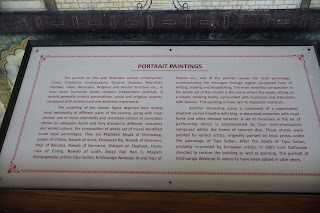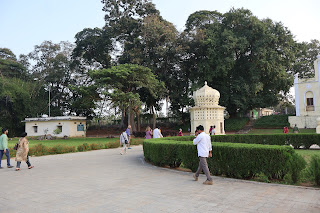Daria Daulat Bagh (literally "Garden of the Sea of Wealth') is a palace located in the city of Srirangapatna, near Mysore in southern India.
Srirangapatna is an island in the river Kaveri, about 14 km from Mysore. In Srirangapatna is the Dariya Daulat Palace (Summer Palace) that is set amidst beautiful gardens called Daria Daulat Bagh.
Tippu Sultan popularly known as the "Tiger of Mysore", built this palace in 1784 and ruled Mysore from here for a short time after his father Hyder Ali wrested power from the Wodeyars in the middle of the 18th century.
The palace is built in the Indo-Saracenic style and is mostly made of teakwood.
|
Approaching Tippu Sultan Summer Palace from the south |
|
South entrance to the garden |
|
Panorana of the garden
|
|
DARIA DAULAT BAGH (SRIRANGAPATNA) «Srirangapatna, the abode of Sri Ranganatha has a chequered history. During the time of Hoysala ruler Udayaditya, brother of Vishnuvardhana, a small town flourished here. A fort was built here in AD. 1454 by the local Nagamangala chief Timmana Dandanayaka during the Vijayanagara rule and it was directly ruled by Vijayanagara viceroys. Mysore Wodeyars took possession of this place during the reign of Raja Wodeyar, which ultimately became the capital of Haider Ali and Tipu Sultan till it was captured by the British in AD. 1799. The summer palace of Tipu Sultan built in 1784 CE, is located outside the fort, on the bank of river Kaveri. It is constructed in the center of a well designed garden in the Indo-Islamic style. Daria Daulat Bagh means “Garden of the Sea of Wealth” and as the name suggests, the Palace might have been constructed in commemoration of Tipu Sultan's victory extending to the seas. The Palace built mostly of teak wood is rectangular in plan and stands on a raised platform. Open corridors with wooden pillars at its edges run along the four sides of the Palace. The inner building is square in plan, while the eastern and western wings trave walls, the other two wings have recessed bays with pillars supporting the roof of the upper storey. There are four staircases for the upper storey that are hidden in the dark rooms, concealed in the walls. The first floor has a small hall with projecting balconies in the centre. It is said that Tipu used to receive his ambassadors and guests in this hall. On the east and west sides there are three rooms each that are probably used for living purposes. The most striking feature of the building is that the entire space on the walls and the roof, pillars, canopies and arches is painted artistically. The outer walls depict battle scenes and portraits and the interior walls are decorated with scrolls of thin foliage and floral pattern. The paintings on the western wall depict four large battle scenes and emphasize the glorious victory of Haider Ali and Tipu Sultan over the English contingent led by Colonel Bailey in 1780 in Second Anglo-Mysore war. The eastern wall contains many portraits of contemporary rulers in five rows. Traces of fountains exist on four sides to speak out the beautifications of the ambience of the palace. Presently, the ground floor of the palace is utilized for Archaeological Site Museum amidst a garden maintained by Archaeological Survey of India.» |
|
Entering the summer palace from south |
|
West wall |
|
Colonel Baillie's Defeat In The Polilur War (Lower Panel) «The lower part of this panel illustrates battle of Polilur (second Mysore war 1780-82 A.D.) the procession of Haider Ali and Tipu Sultan represented in one side and at the centre depicts Colonel Baillie's defeat with special prominence to the explosion of ammunition stock and to the consternation of British soldiers in square, on the other side native Cavalry and French troops also can be seen. Colonel Baillie is in palanquin carried by six native soldiers as he is wounded, but astonished, who bites his index finger amazingly. Captain Baird and Colonel Fletcher, British officers are on horseback featured with elongated hat, cross belted red over coat, white breeches, black shoes and white belted uniformed British Soldiers are in a position to protect their leader. Colonel Baillie with musket is prominent in this panel. A lot of chaos horror on the faces of the warriors in equaled on the face of the their horses. The British square is attacked by Cavalry troops of Tipu Sultan and French army from all directions. On the extreme right top of the panel is standing Mons Lally a French army officer observing the situation with telescope (?) his uniform and cocked hat are almost as magnificent as his leadership. The native warriors are dashing forwarding with swords, a few with bows and arrow. Few soldiers are being trampled to death. There are heads without bodies and vice-versa. The bravery, ferocity, confusion and fear are realistically depicted in this panel.» |
|
Procession of Nizam (Upper Panel) «The upper panel of this mural painting illustrates the procession of Nizam (of Hyderabad) - dressed in dark vest cloth, embroidered turban with semi precious stones - is on a white royal horse under royal umbrella who imperturbably smells a rose, followed by holders of insignia and fanners. In the middle of the panel, two rows of well caparisoned royal elephants, six in each row follow the Nizam with empty howdahs. Three rows of provincial uniformed soldiers carry bow and arrows, swords and shields are in the forward move as escorts. Entire procession is led by two royal elephants caparisoned in tiger striped cloth along with holders of Mysore flag. In the middle of the lower part of this panel are depicted a black boar followed by a white grazing cow, which is a symbolic representation.» |
|
Balcony between the right and left sides of the west wall
|
|
War Procession of Tipu Sultan (Lower Panel) «The lower panel of this mural painting illustrates Tipu Sultan in royal dress, riding on royal horse, under royal umbrella, who imperturbably smells a rose, followed by holder of insignia and fanners. In the midst of the painting shown is his favourite tiger stripes are conspicuous on his banners. Here Tipu is shown conversing with his commander-in-chief (Kamuruddin?) the defense minister Mir Sadiq (defaced later) invites Sultan to the war. His infantry troops composed with swordsmen and spearmen. The Cavalry are uniformed with helmets, long coats, breeches and foot wears, while the infantry were dressed with jackets, breeches and turbans. The French Cavalry is uniformed with long hat, red overcoat, white breeches, long black shoes and swords in their hand. The entire French troops is led by an officer who pointed out as Mons Lally.» |
|
War Procession of Haider Ali (Upper Panel) «The upper panel of this mural painting depicts the war procession of Haider Ali riding on elephant in the middle of his troops marching forth for the battle of Polilur. His army is composed with cavalry, infantry with swords and spear men. The procession is led by hoisting tiger striped flag carrier on elephant and camels. The infantry wear helmets, long coats, breaches and footwear. While the cavalry were dressed in jackets, breeches and regional turbans, Haider Ali is shown in royal and open howdah with royal personages. In front of him, few musicians holding fanfare, trumpet, drummers are illustrated. The royal horses with insignia are depicted at the middle of the painting. No European troops are featured in this panel.» |
|
North wall |
|
Balcony on the north wall |
|
Panorama of the north wall |
|
East wall |
|
Portrait Paintings «The portrait on this wall illustrates various contemporary rulers, Chieftains, Ambassadors, Queens, Nawabs, Marathas, Peshwas, Fakirs, Musicians, Religious and Secular Structure etc., in total seven horizontal bands contains independent portraits. It reveals generally historic personalities, social and religious aspects, composed with architectural and aesthetic importance. The modeling of the human figure depicted here mostly royal personality of different parts of the country, along with royal person, one or more attendants and sometime visitors or councilors shown on adequate depth and they dressed in different costumes and varied colours, the composition of whole set of mural identified some royal personages. They are Madakari Nayak of Chitradurg, queen of Chittor, Nawab of Arcot, Khatewad Raj, Nawab of Savanoor, Raja of Banaras, Nawab of Kannanur, Walajah on Elephant, Hindu raja of Coorg, Nawab of oudh, Balaji Baji Rao Il, Magadi Kempegowda, prince Tipu Sultan, Krishnaraja Wodeyar Ill and Raja of Tanjore etc., one of the portrait reveals the royal personages communicating the messages through pigeon composed here of writing, reading and dispatching. The most beautiful composition in the whole set of this murals is the scene where the queen sitting on a corpet, smoking hukka, surrounded with musicians and attendants with fanners. This painting is more akin to Rajastani miniature. Another interesting scene is composed of a caparisoned elephant carries howdha with king, is decorated costumes with royal horse and white dressed servants. A set of musicians in the art of performing dance is accompanied by four instrumentalists composed within the frame of covered dias. These murals were painted by various artists, originally painted by local artists under the patronage of Tipu Sultan. After the death of Tipu Sultan, probably re-painted by European artists. In 1855 Lord Dalhousie directed to restore the building as well as painting. The portrait of Krishnaraja Wodeyar III seems to have been added in later years.» |
|
Tipu Sultan as Prince «This portrait of Tipu Sultan as a Prince is depicting him as a great warrior in royal dress, with curved mustache, wearing a blueish gold dotted embroidery overcoat with twisted turbans, upturned shoes, holding sword by left hand as well as keeping dagger through his waist, In moving posture against the back-drop of a cloudy blue sky, half seen trunk a coconut tree to his left. This oil portrait has 3-dimensional effect (when we look at this painting from any angle it looks towards us). Painted by John Zoffany in 1780 when Tipu was just 30 years old.» |
|
Water channel with water jets (dry) in the center of the garden |
|
Panorama of the garden entrance seen from the north |
See Also
Source
Location













































